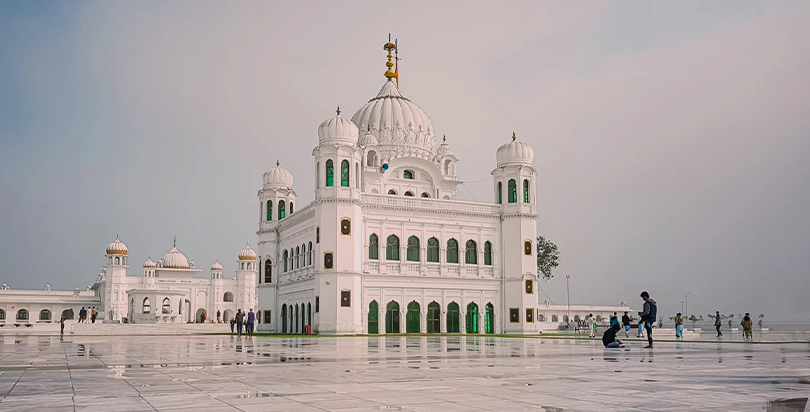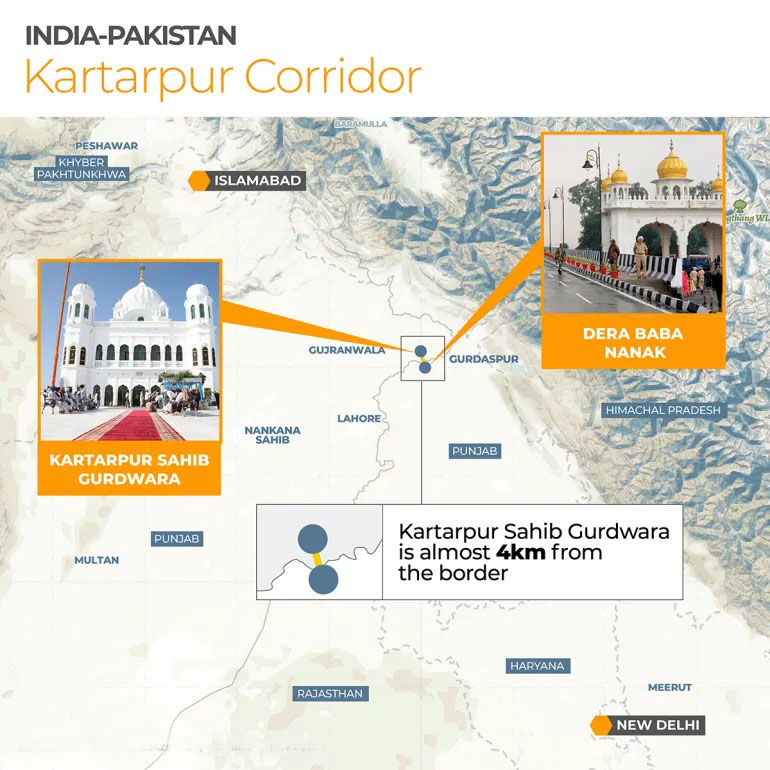A Complete Tour Guide To Kartarpur Corridor, Pakistan
 |
Introduction
Kartarpur Corridor Pakistan is a Holy land for the Sikh religion. The Founder of the Sikh Religion Baba Guru Nanak Dev Ji spent the last 18 years of his life at Kartarpur.On 22 Sep 1539, when Guru Nanak departed for his heavenly abode, Hindus and Muslims disagreed on how to perform the last rituals i.e. Cremation or Burial and both communities carried out the burial as per their traditions. The existing Mazaar and a Samadh are evident in this regard. The Gurdwara is, therefore, considered to be the most Sacred Shrine of the Sikh religion. The original abode (Gurdwara) established by Guru Nanak in 1515 was washed away by floods from the river Ravi and later Maharaja Ranjit Singh built the present-day building in the 19th century. After the partition in 1947, Sikh Community migrated to India, and Gurdwara was left abandoned. Since 1947 Sikh Community of India and across the World was desirous of access to the Gurdwara from India because its just about 4-5 KM from Pakistan-India Border. Kartarpur Corridor is functioning under an MOU between Pakistan and India. 5000 Yatrees are allowed to enter from the Indian side on a daily basis.
Historical and Spiritual Significance
Birthplace of Sikhism. Guru Nanak Dev Ji, born in 1469, spent a significant portion of his life in Kartarpur. It is the place where he established the foundations of Sikhism, promoting equality, selfless service, and devotion to God.
Gurdwara Darbar Sahib Kartarpur. This Gurdwara was constructed to commemorate Guru Nanak's life and teachings. Sikhs consider it one of their holiest sites, making pilgrimage to seek spiritual guidance and solace.
Living Legacy. The teachings of Guru Nanak continue to influence Sikh beliefs and practices. His emphasis on compassion, equality, and social justice is a cornerstone of Sikh identity.
Symbol of Peace. The corridor stands as a symbol of peace and cooperation between India and Pakistan, allowing people to transcend borders in pursuit of their spiritual beliefs.
Fulfillment of a Longing. The corridor fulfills the long-held dream of many Sikhs to visit the sacred site and pay homage to Guru Nanak Dev Ji.
Cultural and Community Significance
Unity and Harmony. Kartarpur significance goes beyond religious boundaries. It promotes unity and understanding among people of various backgrounds who come together to honor Guru Nanak's teachings.
Cultural Preservation. The town and Gurdwara serve as a reminder of Sikh heritage and history. They attract visitors from around the world who wish to learn about Sikhism's cultural and spiritual aspects.
Sikh Identity. Kartarpur reinforces the Sikh identity by allowing followers to connect with their roots, history, and spirituality.
Administrative Control
The Kartarpur Corridor, inaugurated in 2019 and run by the Global Nobel Management Authority, FWO for the 02-years. Thereafter the Federal Government established Project Management Unit (PMU), Kartarpur Corridor on 01.11.2021 as a self-revenue generating body to manage Kartarpur Corridor Project under the administrative control of Evacuee Trust Property Board (ETPB) and Ministry of Religious Affairs and Interfaith Harmony. The ETPB carries out necessary coordination with other departments responsible for the smooth functioning of the project.
Visa Process
As per Bilateral Agreement dated 24.10.2019 between the Government of Islamic Republic of Pakistan and the Government of the Republic of India, the Indian Sikh pilgrims are allowed to visit the GDSK without a visa from dawn to dusk on payment of 20 $ as service charges through the Kartarpur Corridor. The night stay is not allowed for pilgrims coming through corridor. This has been a historic and emotional moment for Sikhs who were previously unable to access the site easily due to political and geographical barriers.
What To Do On The Visit To Kartarpur Corridor?
Apart from visiting Baba Guru Nanak's shrine, pilgrims and other tourists from Pakistan can visit the Passenger Terminal's neighboring viewing point, from where they can view the India-Pakistan Border Fence, Kartarpur Sahib, and Pakistan's Passenger Terminal. Around the corridor entrance, there is also a Gurdwara that serves langar and a variety of street food sellers.
If you are a Pakistani and are concerned about costs or whether you will be permitted to enter the Gurdwara, the good news is that you will have simple access to the Gurdwara, but you must always have your CNIC with you. You will be given a visitor's card when you register, which you must wear throughout the trip.
Best Time to Visit Kartarpur Corridor
For Pakistanis
The optimum time to get to the Gurdwara is before 1:00 p.m. because you'll need at least 2 hours to go inside and an hour and a half to tour around. The official closing hour is 6:00 p.m., although anyone arriving after 3:30 p.m. or 4:00 p.m. would be denied entry.
For Foreigners/Indians
It is preferable to arrive early in the morning so that you can easily park your car and visit the shrine. By 10 a.m., the area becomes crowded and packed with worshippers visiting the viewpoint.
Is It Necessary To Take A Covid-19 Test Before Visiting Kartarpur Sahib?
Yes. All foreign visitors must have a Covid negative RTPCR report that is less than 72 hours old, according to Pakistani government requirements. Visitors may be subjected to a quick antigen test once they reach Pakistan.
Important things
-
Religious pilgrimage opportunity – The agreement between the two nations has given the devotees of Guru Nanak an opportunity to visit the place where he lived. It also creates a chance for the betterment of the political relations between the governments of two nations.
-
Langar organized by Pakistan government – The Pakistan government has announced that it will take the necessary measures to organize a Langar for the visitors. Delicious food will be served from this community kitchen to the pilgrims. Additionally, the Pakistan government will also ensure that the devotees can pay their respects and collect the Prasad.
-
Visitation charges – All pilgrims, who visit the sacred place, will have to pay a visitation fee to the Pakistan government. Each pilgrim must pay $20 to get the necessary permission.
-
PTB construction – For the convenience of the passengers, travelling from India, the authority has constructed the Passenger Terminal Building. All security and document checks will be completed in this complex.
What are the things that Indian pilgrims must do?
- Children and aged people cannot travel on their own – The scheme guidelines highlight that is the age of the child is less than 13 years and if the elderly person is of 75 years or above, then they will not be allowed to travel alone. They must be a part of a group to get the destination.
- Carry eco-friendly items – The Indian government has stressed that the pilgrims must take the necessary measures not to pollute the sacred site. Thus. The pilgrims will be allowed to carry environment friendly items with them.
- Currency limitation – The pilgrims will not be allowed to carry more than Rs. 11,000 while they are on the journey to visit the Gurudwara.
- Baggage limitations – It has been mentioned in the journey guidelines that every person will only be permitted to carry a single bag. The weight of the luggage must not exceed the 7 kg mark.
What are the things that Indian pilgrims must not do?
- Abide by the negative list – When the applicant will attain the ETA, he/she will also get a digital document that highlights all the things that they are not supposed to carry or do. Every pilgrim must abide by these rules.
- No smoking or drinking – Once the pilgrims enter the Passenger Terminal Building, they will no longer be able to indulge in any smoking or drinking activities till the end of the pilgrimage. These items will be mentioned on the negative list.
- Staying vigilant is the key – The scheme guidelines also highlight that the Indian citizens are not allowed to touch anything that is not claimed by any person. They must be alert at all times. It will assist them to detect apprehensive events and people. In such cases, they must get in touch with the authority without fail.
- Permission for taking pictures – The scheme also mentions that the pilgrims will not be allowed to take any snaps of the area. They can do so only if they possess special permission from the authority.
- No loud music – The Indian government also forbids the playing of any form of high pitched music. It will restore the peace and sanctity of the site.
Geographical Location
 |
How to Reach Kartarpur Corridor
Access Points:- There are two main access points to consider while planning a visit to the Kartarpur Corridor.
a) From Indian Side:
i) Dera Baba Nanak, India. This is the starting point for Indian pilgrims. It is well-connected by road and rail to major cities in India, with Amritsar being the nearest major city.
ii. Gurdwara Darbar Sahib Kartarpur, Pakistan. Pilgrims from around the world can access the corridor through this entry point, which is located near the town of Narowal.
iii. Reaching Dera Baba Nanak, India. By Air the nearest airport is Sri Guru Ram Dass Jee International Airport in Amritsar, which is well-connected to major Indian cities. From the airport, Sikh Pilgrims can hire a taxi or use local transportation to reach Dera Baba Nanak. By Train, Amritsar Junction is the nearest major railway station. Trains connect Amritsar to various cities across India. From Amritsar, local buses and taxis are available to reach Dera Baba Nanak.
iv. Documents required for crossing the Kartarpur Corridor. Document Requirements, Indian pilgrims need to obtain a special permit, often facilitated by the Indian Government, to access the Kartarpur Corridor. This permit allows them for a visa-free journey to the Gurdwara in Pakistan.
v. Crossing Process. Once Indian pilgrim have the necessary permit, they can proceed to the Integrated Check Post (ICP) in Dera Baba Nanak. From there, they will be guided through immigration and security checks before being allowed to cross the corridor on foot. Bus Shuttle service is available for those pilgrims with mobility issues.
b) From Pakistan Side:
The diaspora pilgrims after getting visa can visit the Gurdawara Darbar Sahib by road i.e. Lahore-Sialkot Motorway (Exit-1 Muridke towards Narowal) total distance from Lahore to Gurdawara is 120-KM.
Location
Siri Darbar Sahib Kartarpur is located at 4.5 km from International Boarder. It was long outstanding desire of Sikh Pilgrims to open the Kartarpur Corridor. First it was proposed back in 1999 by then Indian Prime Minister Mr. Atal Bihari Vajpaee and Mr. Mian Muhammad Nawaz Sharif as part of Delhi Lahore Bus Diplomacy
GPS Map
Layout Plan of Kartarpur Corridor
 |
 |
 |
Media / Documentaries
Ongoing Activities
Governor Punjab, Ch Sarwar visited Gurdwara Darbar Sahib Kartarpur to see the progress of work on Kartarpur Corridor
 |
 |
 |

.png)